

How some people can end up living at airports for months – even years – at a time. In January, local authorities arrested a 36-year-old man named Aditya Singh after he had spent three months living at Chicago’s O'Hare International Airport.
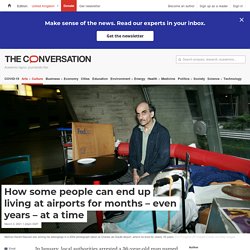
Tokyo Noise (2002 Documentary)
Train Journeys. Oklahoma City. Exercises in Urban Reconnaissance. Las Vegas. Bridges & Doors: The Will to Connection – Threshold. By David Beer When it comes to the demarcation of social spaces and flows, Georg Simmel’s best known work is undoubtedly ‘The Metropolis and Mental Life’.

But there is much else that deals with questions concerning thresholds in his work. As David Frisby and Mike Featherstone have pointed out, the ‘theme of sensory distance and proximity’ is common in Simmel’s work, and especially his work on space. You can find these themes in his essays on topics ranging from trade exhibitions to alpine journeys – covering the period from the 1890s through the early 1900s. It is well-known that Simmel mostly produced shorter works that captured the fragments of social life, or the ‘fragments of modernity’ as Frisby has put it. Simmel’s essay ‘Bridge and Door’ was originally written in 1909, an English translation was published in 1994 in Theory, Culture & Society (translated by Mark Ritter and introduced by David Frisby). Centre for URBan Research - Sociology, The University of York. Nightmare in Berlin by Hans Fallada review – a compelling portrait of postwar Germany.
Hans Fallada’s career was chaotic and disastrous.
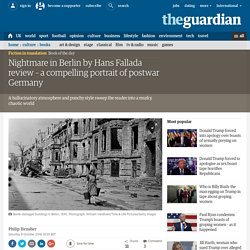
Posterity is lucky to rescue anything from the long catastrophe. In ideal circumstances, he would have been the sort of novelist to address social issues in a popular, palatable style, enjoyed by a wide and serious-minded readership. As it happened, he had the bad luck to write in Germany, between the last years of the Weimar republic and the end of the second world war. The circumstances in which Fallada had to write and tried to publish badly affected his novels. Two are worth our attention: Little Man, What Now? These two novels, Fallada at his best, have a curious quality. There is a good biography in English by Jenny Williams.
The heart of darkness that still beats within our 24-hour cities. On some nights, in the insomniac intervals between rumbling goods trains, and beneath the sound of ambulance sirens, I can hear owls calling mournfully to one another from the trees that screen the railway tracks running past the back of the house in which I live in inner London.
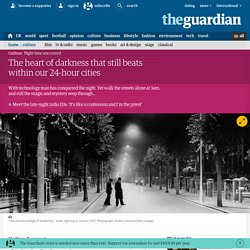
On most nights, alongside the shouts of people fighting or having sex, I hear cats and foxes screaming intermittently, as if they are being tortured. On some mornings, when a thin light first leaks through my blinds, I can hear a cockerel croaking from a garden in which chickens are kept a couple of streets away. A tribute to female flâneurs: the women who reclaimed our city streets.
Baltimore. The Arcades Project Project or The Rhetoric of Hypertext by Heather Marcelle Crickenberger. Aberdeen. Los Angeles. Cities in Conflict. The Subway in Stockholm, Sweden Features Incredible Designs at Each Stop. The subway in Stockholm, Sweden, is unlike any other metro system in the world.

Although different subway systems throughout Europe tend to decoration their stops (like the Paris metro, for example), Stockholm’s metro system is seemingly dedicated to taking fantastical art deep beneath the city’s streets. John Gray and Will Self - JG Ballard. Baudelaire, Benjamin and the Birth of the Flâneur. On voit un chiffonnier qui vient, hochant la tête,Butant, et se cognant aux murs comme un poète,Et, sans prendre souci des mouchards, ses sujets,Epanche tout son coeur en glorieux projets.
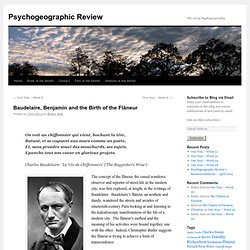
Charles Baudelaire: ‘Le Vin de Chiffonniers’ (‘The Ragpicker’s Wine’) Charles Baudelaire.
Shoefiti. Bucharest. The Art of Looking: What 11 Experts Teach Us about Seeing Our Familiar City Block with New Eyes. By Maria Popova.
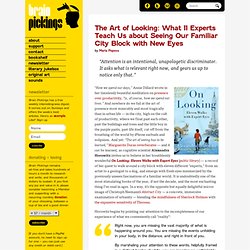
Detroit. Athens. MICHAEL WOLF PHOTOGRAPHY. Lagos. Radical Black Cities. Occupy Wall Street has provided a dramatic reminder that cities still matter as spaces of participatory democracy and engaged citizenship.
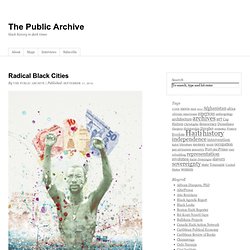
Manchester is the most linguistically diverse city in Europe. It boasts City and United, Corrie, world-renowned bands and famously inclement weather.
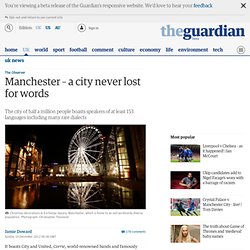
And now Manchester has another claim to fame: the city is arguably the most ethnically diverse in Europe and, possibly, second only to New York in the world. Linguists at the University of Manchester have discovered that their city boasts a population that speaks at least 153 languages, making it one of the world's most diverse places linguistically. Samba e Choro. I think the cities we remember best are the ones that greet us with the utmost cruelty. I arrived in Rio after some months in Salvador de Bahia, fleeing a break-up: Europe was throwing itself into its sinister Christmas, and I thought that the summer sun of an unknown city might be a good way to dodge what was coming over me. It never stopped raining – not for a single moment – during the first week, and the city was empty. Horizontal deluges swept the desolate beach.
You couldn’t even guess that there might be a sun, and by six in the afternoon the cats-and-dogs rain turned into a night of raining wolves. On one of those nights, out of pure despair, I decided to go to a downtown nightclub. The taxi was leaving behind the majestic backdrop of Rio’s maritime facade. ‘My God,’ I thought, completely absorbed by my role as astronaut stranded on a hostile planet, ‘I’ll never get inside this implacable city. Of course, I ended up living there for two years.
Los Angeles Plays Itself - Part 01 / 12. Handheld Time Machines. The modern explorer has it all.
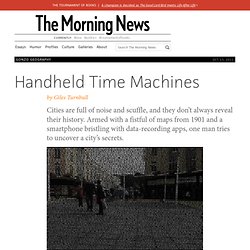
Every gadget you can think of combined into a pocket-sized smartphone. There’s no need to be lost, or lonely, anywhere. Ever. Unless we explore with our eyes closed, figuratively speaking. Istanbul. Paris. London. Homelessness.